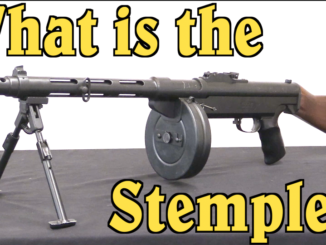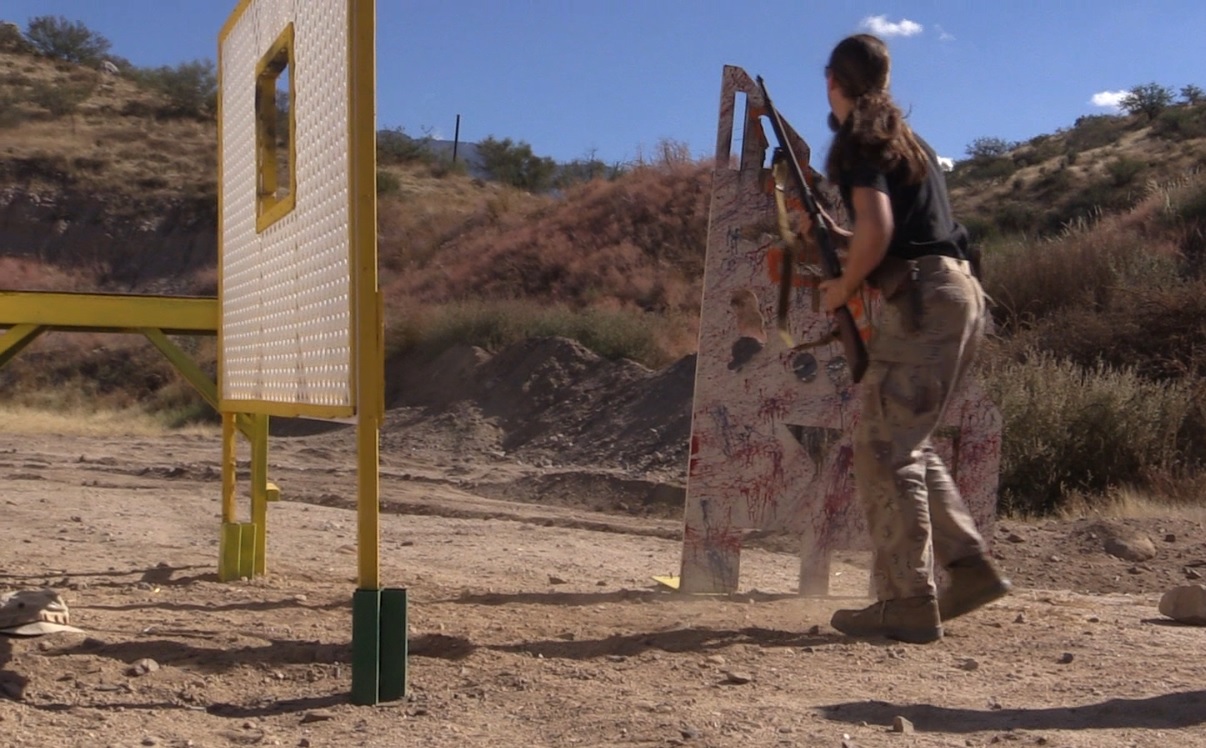We’ve had this particular gun listed as unidentified for quite a long time, and had people suggest pretty much everything you can imagine to explain its origins:
 Well, thanks to a private collector we visited, we now know what it is. The gentleman had a pile of WWII-era Aberdeen Proving Ground photos which include several shots of this particular gun, including the label information. The gun is a .30 carbine submachine gun invented by George Hyde, and it was photographed by Aberdeen on May 8th, 1944. The gun is particularly interesting for its use of a quick-change barrel mechanism obviously copied off the German MG42:
Well, thanks to a private collector we visited, we now know what it is. The gentleman had a pile of WWII-era Aberdeen Proving Ground photos which include several shots of this particular gun, including the label information. The gun is a .30 carbine submachine gun invented by George Hyde, and it was photographed by Aberdeen on May 8th, 1944. The gun is particularly interesting for its use of a quick-change barrel mechanism obviously copied off the German MG42:

That’s a totally obvious copy of the MG42 (which had only been around for a couple years), but one really has to wonder why a quick-change barrel would be necessary on a submachine gun. It neat to look at, sure, but how could Hyde conceivably justify the extra manufacturing cost in 1944?
George Hyde is not a well recognized name, but was very active and involved in the American war effort. He was designing submachine guns at least back to 1933, and one of his guns (the Bendix-Hyde carbine) was entered in the Light Rifle trials which would eventually lead to the M1 Carbine.He also had a hand in the development of the Liberator pistol, designed the M2 submachine gun that was briefly adopted as a substitute standard, and designed (in cooperation with Inland’s Frederick W. Sampson) the M3 “Grease Gun” that replaced the Thompson in US military service. Quite the prolific designer! Unfortunately, no known examples of this gun remain in existence.
You can see all of the Aberdeen photos of his 1944 design here (download the gallery as a high-res archive):
[nggallery id=155]




Why QCB? Simple – because it was a neat thing to have, and that’s why 🙂 Mind you, QCB was a fashion item in European SMGs in 1930s, to quote just Finnish Suomi KP/31 and Polish wz.39 Mors – Mr. Hyde could have picked it from there. And besides, MG 42’s QCB is a simple, elegant solution, while his .30 Carbine was rather not, to put it mildly. Who knows, maybe someone would have seen Dr. Jeckyll in it, if fitted with the QCB?
Although wasteful for most designs, the quick change barrel was actually a used feature on the KP/31. The 90 round magazine, hot ammunition, exceptional production quality and weight meant that it was used as a kind of compact LMG/trench broom and not a sidearm for noncoms.
This Hyde gun may have been a mystery to some, but certainly not to readers of the first edition of The World’s Assault Rifles by Daniel Musgrave and Thomas B. Nelson, published in 1967 with the photos seen here.
Immediately preceding U.S. entry into WWII George Hyde also developed a series of .45 caliber submachine guns that superficially resembled a Thompson, initially with a finned barrel. He died about 1964; I recall seeing his obituary on the UPI newswire.
He is best remembered for his work on the M3 Grease Gun, and he may very well have been the inventor of the system in which the bolt does not need to closely fit the stamped-metal receiver, but is guided by the recoil spring guide rods. This was later adapted to many other guns, notably the AR18 and the Ultimax 100.
M
It really looks like a sheet metal thompson, which is interest. The bolt has the rat-tail, similar to a Solothurn MP-34, where it looks like the spring is contained within the buttstock.
This appears to be an interesting example of “making a gun out of sheetmetal” rather than “making a sheet metal gun”. This is sort of like making a plastic AR receiver, as opposed to making a Glock, wherein the gun was designed around the materials used.
The Grease was truly an improvement.